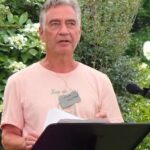Remembering Stuart Bartow

Tom Sacramona
A Wandering Aengus
I first met Stuart Bartow six years ago at Robin White’s Wild Graces. I fell in love with the world that his poetry evoked, one filled with tiny creatures and sincerity—with moths, birds, dragonflies, and always stars. I wrote to Robin after Wild Graces, thanking her for the day and telling her how much I enjoyed meeting Stuart. Knowing my philosophy interests, Robin was quick to recommend Stu’s book of prose vignettes, Teaching Trout to Talk: the Zen of Small Stream Fly Fishing. I looked in my bag, glad that I had just bought that from him. He even kindly signed his name with a shamrock.
Teaching Trout to Talk has only eight haiku in the back, which predate those in Quaking Marsh—his first collection of haiku—and the vignettes are from before he wrote haibun, a genre in which he would later excel. I immediately recognized that I was holding a gem and that there was something important about this book, which Stu wrote over seven years. Of all his writing, Teaching Trout to Talk contains the most of himself tucked away between its pages. His life’s wisdom is humbly offered to the reader, served up with his characteristic good humor and singular way of seeing. In one vignette called “Koans,” Stu wonders, “If you fish where there are no fish, are you still fishing?”
Teaching Trout to Talk is not a linear book either. In true Zen fashion, it’s one a reader can open to any page and begin with pleasure. That is how I re-read the book earlier this year. There are so many quotable lines and smart allusions (he was a teacher of writing and literature at SUNY Adirondack and chair of the Battenkill Conservancy). It has an indelible focus on the present moment: “Nothing puts you on the cusp of experience, inside the moment, or outside of time, like catching a fish with a light fly rod.”
I also spent time with Stuart’s poetry collection Green Midnight. One of its poems, “The Muse,” speaks to where poetry originates for Stu:
I’m superstitious about calling the muse,
don’t want her to get the wrong
idea. Who needs to make
a poem every day
when one has real work to do,
shoveling snow, washing dishes,
drinking? And doesn’t she
have other things to do, like
tend to her other loves,
that mountain in Greece, the wind
at 4 a.m., the Milky Way?
Making visitation to those lost souls
who need to write something
about love, or despair,
or loneliness.
The man I knew was an eclectic wandering Aengus at home in a patched flannel, who could catch trout with nothing more than a hazel wand and a berry (from “The Song of Wandering Aengus” by William Butler Yeats, used by Stu as a prologue in Teaching Trout to Talk). He possessed a poet’s shyness, but intensely vibrated to the cosmos he navigated with a star guide—his partner and forever muse, the poet Barbara Ungar.
For Stu, poetry was the art of communication with the divine and a means of connection to other people and creatures—calling up, checking in, and recalibrating the soul. Stuart always wrote with a burning heart, and I think that is why he flew like a comet into our community in such a large way.
About the Author

Tom Sacramona is a poet living in Massachusetts. He served as editor of the Haiku Society of America’s journal Frogpond from 2021 to 2023 and is now an editor at bottle rockets haiku magazine. His first chapbook is Light Speed.
